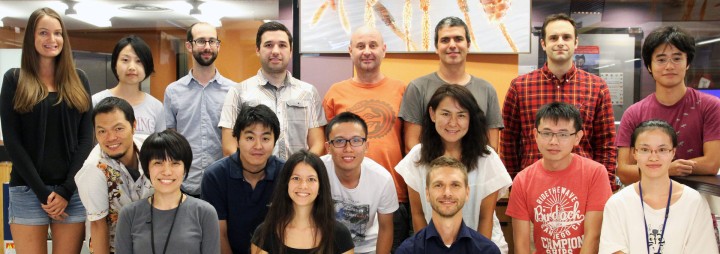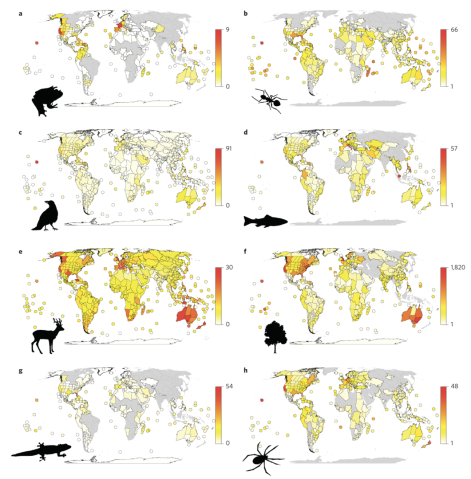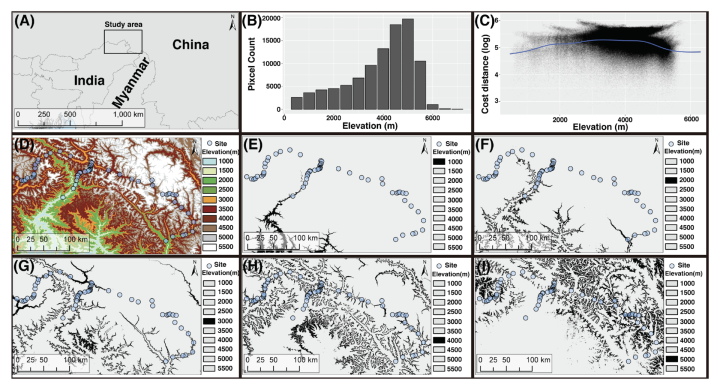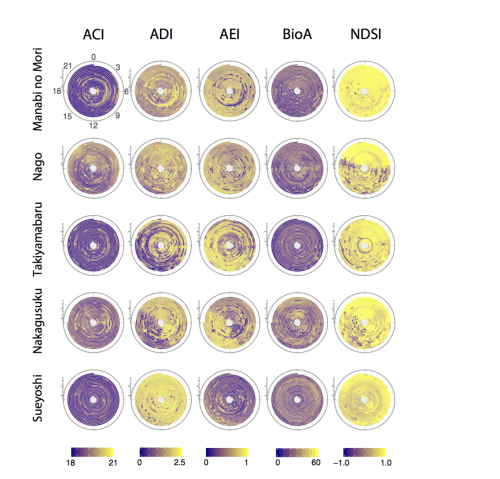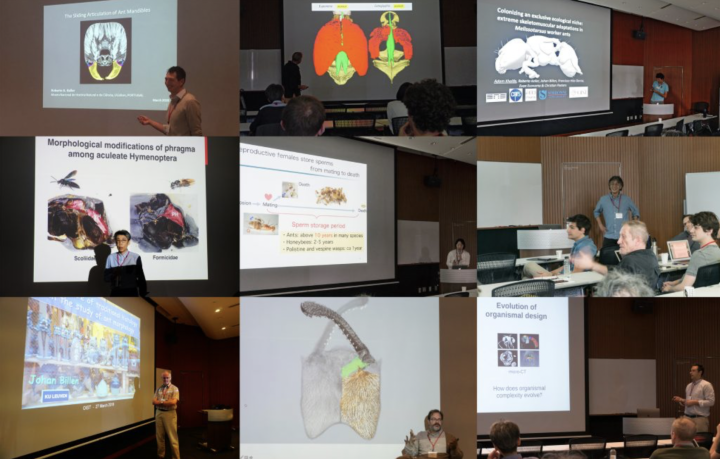Biodiversity and Biocomplexity Unit
Professor Evan Economo
Abstract
Our lab seeks to understand how ecological and evolutionary processes interact to generate and regulate biodiversity across spatiotemporal scales and levels of biological organization. Living systems are diverse from gene sequences to organismal morphology to communities and ecosystems. Our goal as biologists is not just to document and catalogue this diversity, but understand the complex interactions and dynamics that generate and sustain biological variation. In FY2017, our research concentrated in five areas; our project on the evolution of the hyperdiverse ant radiations, our Global Ant Biodiversity Informatics (GABI) project which focuses on compiling analyzing global distributions of past and present ant biodiversity, and systematics, ecology, and evolution of Indo-Pacific ant faunas, the OKEON Churamori Project, and X-ray microCT imaging.
2. Activities and Findings
2.1 Global Ant Biodiversity Informatics (GABI) Project
Our understanding of large-scale biodiversity patterns has recently increased dramatically, but available information is strongly biased towards a few groups of vertebrates and plants. Biodiversity patterns in invertebrates, such as insects, are poorly documented despite representing the large majority of species. To address this gap in our knowledge, the Global Ant Biodiversity Informatics (GABI) project has compiled over 250 years of ant research into a single database providing distribution information for all ant species. These data can be used to support all kinds of research and are being used somehow in most of our ant projects. However, the two main analyses we are working on with these data are analyzing global ant diversification patterns across the globe, and a comparison of how global patterns of ant endemism compare with vertebrate groups.
In FY2017, we have continued to maintain and build the GABI dataset so it can be used for different research purposes. Notably, in this fiscal year we joined large-scale cross-taxon efforts to map and understand the spread of alien species around the world. These include papers on global alien species hotspots (Dawson et al. 2017, Nature Ecology & Evolution), and the dynamics of emergence (Seebens et al. 2017, PNAS). The GABI dataset has also been used for other systematics studies (e.g. Sarnat et al. 2017, BJLC, Agavekar et al. 2017, PeerJ). We received a Kakenhi grant to improve the dataset by large scale georeferencing and species distribution modeling.
2.2 Evolution, Ecology, and Systematics of Hyperdiverse Ant Radiations
Over evolutionary time lineages evolve in and out of ecological niches, evolve through morphological spaces, and ranges expand and contract in geographic space. These transitions may not be independent, some phenotypes may be better suited to certain ecological habitats, some habitats may promote dispersal and colonization, and colonization of new geographic areas may lead to ecological niche shifts. These ideas form the basis for integrative hypotheses like the taxon cycle. In collaboration with the Knowles lab at the U. of Michigan, we have a funded project to examine the joint dynamics of these transitions in the famously diverse ant genus Pheidole, which contains over 1000 described species and is the dominant ant genus in many tropical ecosystems worldwide. We reconstructed a new global phylogeny of the genus and used it to analyze its macroevolution and macroecology, with particular attention to the Old World. We also recently initiated new projects on other hyperdiverse ant radiations, namely the genera Strumigenys (in collaboration with Doug Booher) and Tetramorium (led by Staff Scientist Paco Hita Garcia). Strumigenys is a leaf-litter predator that has evolved a complex trap-jaw mechanism, and we are examining the evolution of this trait in time and space. In Tetramorium, we are analyzing biogeography, morphological evolution, and transitions between ecological generalism and specialism. Specimen work and RAD-sequencing for phylogenomics reconstruction is ongoing for these groups.
In FY2017, we made progress on all of the projects above, with phylogenies available for Strumigenys, Tetramorium, and Pheidole. We published papers on the evolution of ant spines (Sarnat et al. 2017, BJLS), and gave a number of talks on diversification of these genera.
2.3 Biodiversity, Biogeography, and Evolutionary Ecology of Indo-Pacific Ant Faunas
Ants are among the most ubiquitous and ecologically dominant animal groups. Over millions of years, ant biodiversity has evolved and dispersed from Asia and Australia through the vast network of Pacific islands. More recently, humans have unintentionally introduced many species from around the globe into the Pacific. We seek to understand the historical and contemporary processes that regulate ant biodiversity over time.
In FY2017, we continued a series of published works on the Indo-Pacific ant faunas, including a new paper on the biogeography of the prenolepis genus group in the Pacific (Matos-Maraví et al., MPE), evolution of Pheidole (Sarnat et al. 2017, BLC), and completed systematic works on the Indian ant fauna (Agavekar et al. 2017, PeerJ). We also published a paper testing theories for how environment and spatial complexity jointly shape ant communities in mountain environments (Liu et al. 2017, Ecography).
2.4 OKEON Churamori Project
In collaboration with the Mikheyev unit here at OIST, in FY2013 we initiated a major initiative called the OKEON Chura-Mori Project (OKEON stands for Okinawa Environmental Observation Network). The goal is to develop an observation system to measure and monitor the environment of Okinawa, in collaboration with the people of Okinawa. The primary scientific goal is to develop long-term space-time data series from sites across the island.
After finishing deployment of the malaise traps in previous years, we focused on setting up acoustic and camera trap capabilities in FY2017. In addition, we published a paper describing the ecoacoustic project (Ross et al. Ecological Research, 2017, Figure 3) We have also been broadening the activities and partners, we now have over 140 partners in the project. See the OKEON website for more on our activities. We completed an external review of the project and received a positive recommendation to continue the project and activity.
2.5 X-Ray Computed Tomography for Entomology
Since the earliest biological studies, description and quantification of biological structures has been a basic goal of biology as well as a first step toward deeper understanding of ecological and evolutionary processes. In Entomology, the primary imaging tools have traditionally been optical microscopy and SEM, which are essential for certain tasks and allow us to see complex structures well. But these are limited in our ability to quantitatively characterize complex shapes, surfaces, and textures. X-Ray CT has the potential to complement existing tools by providing a digital 3D image of the interior and exterior of the organism. These images can be manipulated, dissected, measured, and quantified. We have been developing imaging and post-processing techniques to better quantify the functional morphology of ants, including both external and internal structures.
In FY2017 we continued a series of papers exploring the applications of microCT to ant systematics research (Agavekar et al. 2017, Hita Garcia et al. 2017) and analyzed the evolution of spines in Pheidole using micro-ct(Sarnat et al. 2017). We are working through generating large 3D datasets on Strumigenys and Malagasy ants which we will be
3. Publications
3.1 Journals
- Choo, J., Carasco, C., Alvarez-Loayza, P., Simpson, B. B., Economo, E. P. Life history traits influence the strength of distance- and density-dependence at different life stages of two Amazonian palms. Annals of Botany, doi: 10.1093/aob/mcx051 (2017).
- Darwell, C. T., Althoff, D. M. The relative contributions of competition and abiotic tolerances in determining the geographical distributions of four closely related Yucca species in Texas. Journal of Biogeography, doi: 10.1111/jbi.12907 (2017).
- Dawson, W., Moser, D., Van Kleunen, M., Kreft, H., Pergl, J., Pyšek, P., Weigelt, P., Winter, M., Lenzner, B., Blackburn, T. M., Dyer, E. E., Cassey, P., Scrivens, S. L., Economo, E. P., Guénard, B., Capinha, C., Seebens, H., García-Díaz, P., Nentwig, W., García-Berthou, E., Casal, C., Mandrak, N. E., Fuller, P., Meyer, C., Essl, F. Global hotspots and correlates of alien species richness across taxonomic groups. Nature Ecology & Evolution, doi: 10.1038/s41559-017-0186 (2017).
- Liu, C., Dudley, K. L., Xu, Z-H., Economo, E. P. Mountain metacommunities: climate and spatial connectivity shape ant diversity in a complex landscape. Ecography, doi: 10.1111/ecog.03067 (2017).
- Agavekar, G., Hita Garcia, F., Economo, E. P. Taxonomic overview of the hyperdiverse ant genus Tetramorium Mayr (Hymenoptera, Formicidae) in India with descriptions and X-ray microtomography of two new species from the Andaman Islands. PeerJ, doi: 10.7717/peerj.3800 (2017).
- Friedman, N. R., Harmáčková, L., Economo, E. P., Remeš, V. Smaller beaks for colder winters: Thermoregulation drives beak size evolution in Australasian songbirds. Evolution, doi: 10.1111/evo.13274 (2017).
- Hita Garcia, F., Fischer, G., Liu, C., Audisio, T. L., Economo, E. P. Next-generation morphological character discovery and evaluation: an X-ray micro-CT enhanced revision of the ant genus Zasphinctus Wheeler (Hymenoptera, Formicidae, Dorylinae) in the Afrotropics. ZooKeys, doi: 10.3897/zookeys.693.13012 (2017).
- Sarnat, E. M., Friedman, N. R., Fischer, G., Lecroq-Bennet, B., Economo, E. P. Rise of the spiny ants: diversification, ecology and function of extreme traits in the hyperdiverse genus Pheidole (Hymenoptera: Formicidae). Biological Journal of the Linnean Society, doi: 10.1093/biolinnean/blx081 (2017).
- Sharaf, M. R., Akbar, S. A., Aldawood, A. S., Hita Garcia, F. Review of the ant genus Nesomyrmex Wheeler, 1910 (Hymenoptera, Formicidae, Myrmicinae) from the Arabian Peninsula. African Invertebrates, doi: 10.3897/AafrInvertebr.58.12782 (2017).
- d’Erricoa, F., Banks, W. E., Warren, D. L., Sgubin, G., Van Niekerk, K., Henshilwood, C., Daniaue, A-L., Goñi, M. F. S. Identifying early modern human ecological niche expansions and associated cultural dynamics in the South African Middle Stone Age. PNAS, doi: 10.1073/pnas.1620752114 (2017).
- Janicki, J., Young, D. K. Nemonychidae and Anthribidae of Wisconsin (Coleoptera: Curculionoidea). Insecta Mundi (2017).
- Lamb, A. D., Watkins-Colwell, G. J., Moore, J. A., Warren, D. L., Iglesias, T. L., Brandley, M. C., Dornburg, A. Endolymphatic Sac Use and Reproductive Activity in the Lesser Antilles Endemic Gecko Gonatodes antillensis (Gekkota: Sphaerodactylidae). Bulletin of the Peabody Museum of Natural History, doi: 10.3374/014.058.0103 (2017).
- Ross, S. RP-J., Lancaster, M. K., Volz, V., Divan, A. A generalizable framework for multi-scale auditing of digital learning provision in higher education. Online Learning (2017).
- Ross, S. R. P-J., Friedman, N. R., Dudley, K. L., Yoshimura, M., Yoshida, T., Economo, E. P. Listening to ecosystems: data-rich acoustic monitoring through landscape-scale sensor networks. Ecological Research, doi: 10.1007/s11284-017-1509-5 (2017).
- Matos-Maraví, P., Clouse, R. M., Sarnat, E. M., Economo, E. P., LaPolla, J. S., Borovanska, M., Rabeling, C., Czekanski-Moir, J., Latumahina, F., Wilson, E. O., Janda, M. An ant genus-group (Prenolepis) illuminates the biogeography and drivers of insect diversification in the Indo-Pacific. Molecular Phylogenetics and Evolution, doi: 10.1016/j.ympev.2018.02.007 (2018).
- Seebens, H., Economo, E. P. et al. Global rise in emerging alien species results from increased accessibility of new source pools. Proceedings of the National Academy of Sciences, doi: 10.1073/pnas.1719429115 (2018).
- Sharaf, M., Al Dhafer, H. M., Aldawood, A. S., Hita Garcia, F. Ants of the Monomorium monomorium species-group (Hymenoptera: Formicidae) in the Arabian Peninsula with description of a new species from southwestern Saudi Arabia. PeerJ, doi: 10.7717/peerj.4277 (2018).
- Thomson, S. A., Pyle, R. L., Hita Garcia, F. et al. Taxonomy based on science is necessary for global conservation. PLoS Biology, doi: 10.1371/journal.pbio.2005075 (2018).
3.2 Books and Other One-Time Publications
3.3 Oral and Poster Presentations
- Friedman, N. R., LeCroq, B., Fischer, G., Sarnat, E. M., Economo, E. P. Morphological divergence and integration among subcastes in the hyper-diverse ant genus Pheidole, Evolution 2017, Portland, Oregon, USA, June 26 (2017).
- Darwell, C., Mikheyev, A. S., Economo, E. P. Using Population Genomics to Assess the Biodiversity Dynamics of an Endemic Ant Radiation in Fiji, 12th International Congress of Ecology (INTECOL 2017, Beijing), Beijing, China, August 21 (2017).
- Economo, E. P. Introducing the OKEON Churamori Project: a new environmental monitoring network in Okinawa, OKEON Churamori Project Symposium 2017, Onna, Okinawa, Japan, July 29 (2017).
- Economo, E. P. Research in the Biodiversity and Biocomplexity Unit, Environmental Sciences at OIST Symposium, Onna, Okinawa, Japan, October 11 (2017).
- Friedman, N. R. Island song: how acoustic monitoring will help us understand and protect Okinawa's biodiversity, OKEON Churamori Project Symposium 2017, Onna, Okinawa, Japan, July 29 (2017).
- Hita Garcia, F. Evolution, 3D ANTS - HOW NEW IMAGING TECHNOLOGIES CHANGE THE ROLE OF MORPHOLOGY IN 21ST CENTURY MYRMECOLOGY, XXIII Simpósio de Mirmecologia: An International Ant Meeting, Curitiba, Curitiba, Paraná, Brazil, October 24 (2017).
- Hita Garcia, F., Fischer, G., Liu, C., Audisio, T. L., Economo, E. P. MICRO-CT FOR ANT SYSTEMATICS: FROM NEXT-GENERATION MORPHOLOGICAL CHARACTER DISCOVERY AND EVALUATION TO VIRTUAL AVATARS OF TYPE MATERIAL, XXIII Simpósio de Mirmecologia: An International Ant Meeting, Curitiba, Curitiba, Paraná, Brazil, October 26 (2017).
- Hita Garcia, F., Friedman, N. R., Economo, E. P. EVOLUTION OF PHYLOGENETIC AND MORPHOLOGICAL HYPERDIVERSITY IN THE GENUS TETRAMORIUM REVEALED THROUGH NEXT GENERATION SEQUENCING, MICRO-CT, AND GEOMETRIC MORPHOMETRICS, XXIII Simpósio de Mirmecologia: An International Ant Meeting, Curitiba, Curitiba, Paraná, Brazil, October 26 (2017).
- Keller, R. A., Hita Garcia, F., Economo, E. P. ANTS PROTECT THEIR MOUTHPARTS WITH A NOVEL INTERLOCKING MECHANISM, XXIII Simpósio de Mirmecologia: An International Ant Meeting, Curitiba, Curitiba, Paraná, Brazil, October 26 (2017).
- Yoshimura, M. A new design of community collaborative project developing in Okinawa, OKEON Churamori Project Symposium 2017, Onna, Okinawa, Japan, July 29 (2017).
- Hita Garcia, F. A biogeographic tale of two ant genera: Reproductive mode and defensive trait suites shape two very different radiations in Madagascar. The 65th Annual Meeting of the Ecological Society of Japan, Sapporo, Hokkaido, Japan, March 16 (2018).
- Liu, C. Comparative phylogeography, phylogenomics, and population genomics of ant genus Strumigenys in the Pacific archipelagoes. The 65th Annual Meeting of the Ecological Society of Japan, Sapporo, Hokkaido, Japan, March 15 (2018).
- Friedman, N. R. Functional diversity and evolution of beak shape across elevational and climatic gradients. The 65th Annual Meeting of the Ecological Society of Japan, Sapporo, Hokkaido, Japan, March 16 (2018).
6. Meetings and Events
In March 2017, we held a mini-symposium on the OIST campus entitled “Advances in imaging, quantifying, and understanding the evolution of ant phenotypes”, with participants from around the globe. The aim of the symposium was to gather a small but selected group of leading researchers interested in the evolution of ant phenotypes with a strong focus on the use of x-ray microtomography (micro-CT). Our list of speakers covered experts in the fields of molecular and morphological systematics, anatomy, functional morphology, comparative morphology, adaptive trait evolution, reproductive biology, linear and geometric morphometrics, and paleontology. All invitees gave outstanding talks and presented published or ongoing research in great detail and with beautiful 2D or 3D illustrations and/or videos.
Some talks provided conceptual and technical backgrounds and perspectives of how to use micro-CT for ant morphology, how to better integrate next-generation phenomics into systematics, palaeontology, and evolutionary biology, and how to use micro-CT data and downstream 3D applications for education and public outreach.
A strong focus of the symposium was the use of micro-CT for ant functional morphology, biomechanics, and the evolution of complex phenotypes. Some guests also showed recent advances in histology-based anatomy and reproductive biology, and shared ideas of how to combine traditional histology with modern 3D imaging technologies, such as micro-CT.
We also had a session focusing on the use of 2D linear and 3D geometric morphometrics and their application for ant phylogenetics, taxonomy, trait evolution, and more generally how to use large 3D phenotypical datasets to answer questions in evolutionary biology.
One afternoon was completely devoted to practical demonstrations of how to use 3D data. Our lab shared how we scan data post-processing, 3D virtual reconstructions, 3D animations, virtual/augmented reality, 3D printing. It was useful for sharing knowledge of methodology, and stimulating ideas for future directions and applications.
The three-day symposium provided ample opportunities for socializing and chatting about on-going and potential collaborations, discussions about methods and research results, as well as brainstorming about future directions for the field
https://groups.oist.jp/bbu/mini-symposium-ant-phenotypic-evolution
6.1 Seminars, “When individuals matter: Biodiversity and the impacts of logging in Borneo”
- Date: April 3, 2017
- Venue: National Centre for Biological Sciences, Bengaluru, Karnataka, India
- Speaker: Mr. Samuel RP-J Ross (University of Leeds, U.K.)
6.2 Seminar, “Large tropical plant genera as islands of biodiversity: new findings from New Guinean Ficus”
- Date: April 13, 2017
- Venue: Seminar Room C700 - Lab 3, OIST
- Speaker: Dr. Simon Segar (University of South Bohemia, Ceske Budejovice, Czech Republic)
6.3 Seminar, “Insects and their multi-trophic interactions in natural and experimental forests”
- Date: April 13, 2017
- Venue: Seminar Room C700 - Lab 3, OIST
- Speaker: Dr. Michael Staab (University of Freiburg)
6.4 Seminar, “Reorganization of taxonomic, functional, and phylogenetic ant biodiversity after conversion to rubber plantation”
- Date: May 19, 2017
- Venue: School of Biological Science, University of Hong Kong, Hong Kong SAR, China
- Speaker: Mr. Cong Liu (OIST)
6.5 Seminar, “Micro-CT X-ray scanning in 21st century ant taxonomy, evolution and functional morphology studies”
- Date: May 20, 2017
- Venue: School of Biological Science, University of Hong Kong, Hong Kong SAR, China
- Speaker: Dr. Georg Fischer (OIST), Mr. Cong Liu (OIST), Dr. Francisco Hita Garcia (OIST)
6.6 Seminar, “Geometric Ecomorphology: Shape Analysis, Taxonomy, Ecology, and the Modeling of Morphological Adaptation”
- Date: June 28, 2017
- Venue: Classroom B700, Lab3 (OIST)
- Speaker: Prof. Norman MacLeod (The Natural History Museum, London, U.K.)
6.7 Seminar, “Geometric morphometrics: using patterns of shape variation to understand processes in evolution and development”
- Date: June 28, 2017
- Venue: Classroom B700, Lab3 (OIST)
- Speaker: Prof. Chris Klingenberg (University of Manchester, U.K.)
6.8 Seminar, “Colonizing an exclusive ecological niche: extreme skeletomuscular adaptations in Melissotarsus worker ants”
- Date: December 22, 2017
- Venue: University of the Ryukyus
- Speaker: Mr. Adam Khalife (IEES-Paris), Dr. Roberto Keller (National Museum of Natural History and Science), Prof. Johan Billen (KU Leuven), Dr. Francisco Hita-Garcia (OIST), Prof. Evan P. Economo (OIST), Prof. Christian Peeters (iEES, Sorbonne Université, Paris)
6.9 Seminar, “3D ants and next-generation phenomics - how new imaging technologies change the role of morphology in 21st century entomology”
- Date: January 22, 2018
- Venue: The National Centre for Biological Sciences (NCBS), Bangalore, Karnataka, India
- Speaker: Dr. Francisco Hita Garcia (OIST)
6.10 Seminar, “3D ants and next-generation phenomics - new imaging technologies change the role of morphology in 21st century systematics”
- Date: January 24, 2018
- Venue: Ashoka Trust for Research in Ecology and the Environment, Bangalore, Karnataka, India
- Speaker: Dr. Francisco Hita Garcia (OIST)
6.11 Seminar, “Studying biodiversity change by using soundscape information retrieval techniques”
- Date: February 7, 2018
- Venue: Seminar Room C700, Lab3 (OIST)
- Speaker: Dr. Tzu-Hao Lin (Research Center for Information Technology Innovation, Academia Sinica)
6.12 Seminar, “Rapid evolution of a costly form of parasite resistance in threespine stickleback”
- Date: February 23, 2018
- Venue: Seminar Room C700, Lab3 (OIST)
- Speaker: Dr. Daniel I. Bolnick (University of Texas at Austin)
6.13 Seminar, “Global change and the stability of ecosystems”
- Date: February 28, 2018
- Venue: Seminar Room C209, Center Building (OIST)
- Speaker: Prof. Ian Donohue (Trinity College Dublin)
6.14 Seminar, “Temporal dynamics of biodiversity across Okinawa-jima”
- Date: March 1, 2018
- Venue: Hokkaido University, Sapporo, Hokkaido, Japan
- Speaker: Mr. Samuel RP-J Ross (Trinity College Dublin)






